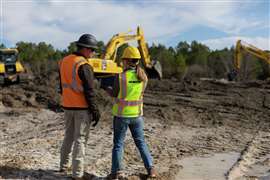Read this article in Français Deutsch Italiano Português Español
How tech can bridge the skills gap
02 April 2024
Construction is one of the largest industries in the world, making up more than 13% of GDP globally.
 Richard Clement says Smart Construction can help bridge the technology gap and drive production improvements. Photo: Komatsu
Richard Clement says Smart Construction can help bridge the technology gap and drive production improvements. Photo: Komatsu
Despite this, it has been slow to evolve and has only recently started implementing technological changes. On top of this, the industry fears a lack of talent, with over 38,000 vacancies recorded per quarter in construction in the UK alone.
Why is there a labour skills shortage in the construction industry?
The construction industry is known to be behind the times in terms of digitalisation, with just 1% currently capitalising on developments in technology. The lack of digital awareness, along with an ageing workforce, contributes to why many young workers don’t see an appeal to join the industry.
There has been a dramatic fall in 16-30-year-olds entering the construction industry meaning a less agile and a less digitally literate workforce at a time when the industry is trying to focus on digital revolution.
How has this impacted the construction industry?
As of January 2023, research found that 80% of construction firms found it difficult to recruit qualified workers. This demographic trend poses a real challenge for maintaining the industry’s vitality and finding a future workforce.
Governments recognise this impending shortfall and are prioritising the skills shortage in Europe with several national and European policies setting new environmental targets that require investment in construction.
It is estimated that the green transition could lead to the creation of between 1 and 2.5 million additional jobs overall by 2030, a positive outlook for the industry.
However, companies would need to have access to a qualified workforce to handle this increasing demand.
 Terrain mapping with Smart Construction Dashboard. Image: Smart Construction
Terrain mapping with Smart Construction Dashboard. Image: Smart Construction
Smart technology is crucial for the future of construction, given a push on new government initiatives, the ageing workforce, and the industry’s move towards tech solutions to alleviate the shortage of lower-skilled workers and attract younger ones.
How can smart technology and digital solutions help alleviate the labour shortage?
Over the next five years, 95% of UK construction companies plan on investing in tech, with the hope of driving more talent into the industry.
There are multiple benefits to investing in smart technology and digital solutions. From upskilling the workforce, reducing the amount of time required at site or remotely to gather information and communicate changes, to providing tracking data to the customer.
Our work with HB Golf in the Czech Republic has shown the potential of smart technology in practice to alleviate pressures on the workforce, freeing up crucial time for employees to undertake tasks that cannot be digitised.
When we initially began speaking with Chris Horn, the Technology Manager at HB Golf, we found that a huge portion of his time was spent on surveying, which is a task he’s now able to delegate to site managers thanks to the solutions we’ve put in place together.
His team uses drone data pulled through to the Dashboard system to get an accurate overview of the site and all survey data.
 Richard Clement, deputy general manager of Smart Construction. Photo: Smart Construction
Richard Clement, deputy general manager of Smart Construction. Photo: Smart Construction
Surveying is a great example of a task that has historically been onerous and time consuming to complete, with results often taking days to be returned to the site team.
Chris has been able to upskill the existing workforce on the site, freeing up his time as well as helping their skill set become more versatile.
Smart technology and digital solutions can upskill current workers, while alleviating pressures on personnel from all stages of the process.
Even individuals who don’t consider themselves tech-savvy can benefit from digital solutions – teams across Europe have found the data easy to analyse and interpret. This means less pressure on workers as the load is shared at the job site.
What’s next?
There are many ways smart technology can help alleviate the labour skills shortage. It’s essential that the industry and employers recognise what the future could look like for the industry and try to make a change, alongside the efforts to alleviate the pressure of an impending shortage of workers.
As smart technology develops it can act as a buffer for the challenges the construction industry could face in the coming decades. It will also help to upskill workers in the future, which is essential, and allow less technically confident workers to enter the industry.
|
About the author Richard Clement is deputy general manager for Smart Construction, a digital transformation strategy created by Komatsu together with Sony Semiconductors, NTT Communication and Nomura Research Institute, under the entity EARTHBRAIN Limited. For more information visit smartconstruction.io |
STAY CONNECTED


Receive the information you need when you need it through our world-leading magazines, newsletters and daily briefings.
CONNECT WITH THE TEAM










